Contents
The yellow-fruited potato variety Kolobok attracted farmers and gardeners with high yields and excellent taste. Description of the variety and reviews characterize the Kolobok potato as a mid-season variety with excellent taste characteristics.
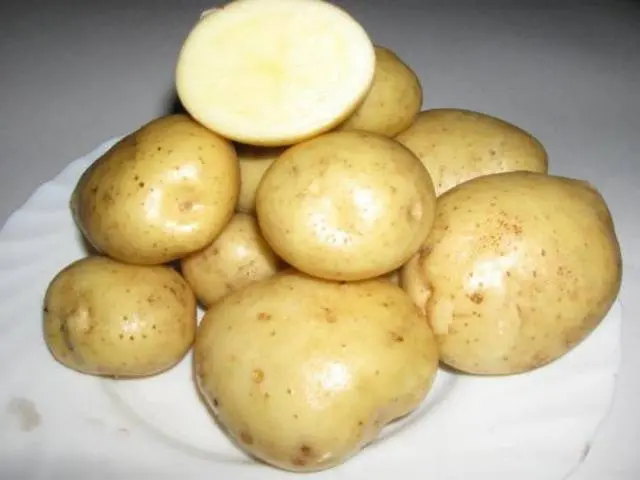
Potato Kolobok was obtained by breeders and has been listed in the State Register since 2005 as a variety recommended for industrial production in almost any region of the country. But the Central Black Earth region is especially preferable for cultivation.
Characteristic of the variety
Potato variety Kolobok is distinguished by a semi-erect bush of medium height with small light green leaves. Wonderful brushes of white flowers adorn the bush.
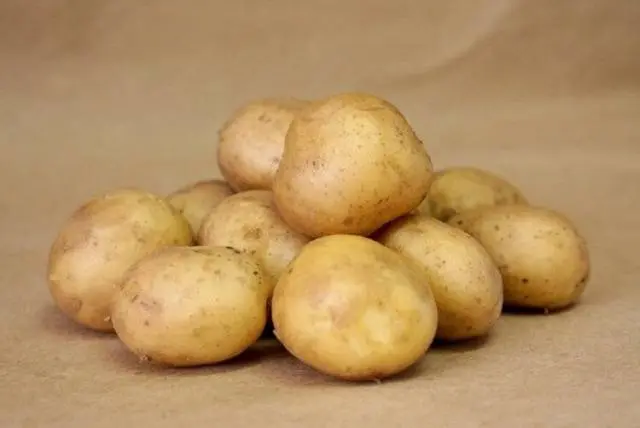
Potato tubers Kolobok stand out:
- round-oval shape without bumps and tubercles;
- rough skin with a yellow tint;
- a small number of shallow, inconspicuous eyes;
- yellowish pulp on the cut of the tuber;
- low starch content – up to 11-13%;
- good keeping quality;
- high resistance to many diseases;
- unpretentiousness in care;
- versatility in use;
- excellent trade dress;
- good transportability.
Each bush of the Kolobok variety can produce up to 15-18 tubers weighing from 90 to 140 g.
The high yield of the variety is also attractive – up to 25 t / ha. Unlike other varieties, the Kolobok potato does not degenerate and does not reduce the yield when planted for many years.
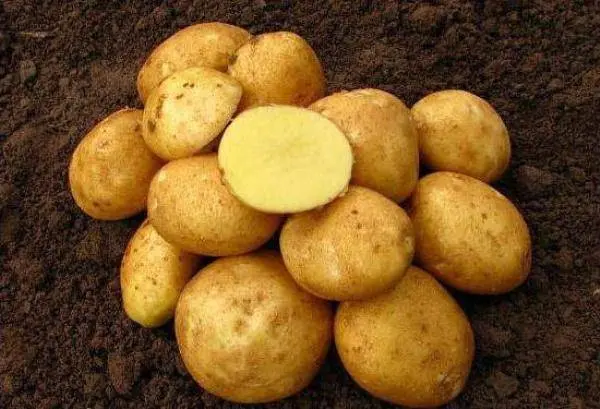
Potato Kolobok, as follows from the description of the variety, photos and reviews, demonstrates high culinary qualities:
- it boils well and quickly, retaining its shape;
- does not darken during cooking and retains color;
- contains a large amount of proteins and carotene;
- has a pleasant, fragrant taste;
- perfect for making potato products – chips, fries, mixtures with vegetables;
- can be used in dietary nutrition.
Small disadvantages that do not detract from the merits of the Kolobok variety include:
- sensitivity to watering and top dressing;
- thick skin making it difficult to peel.
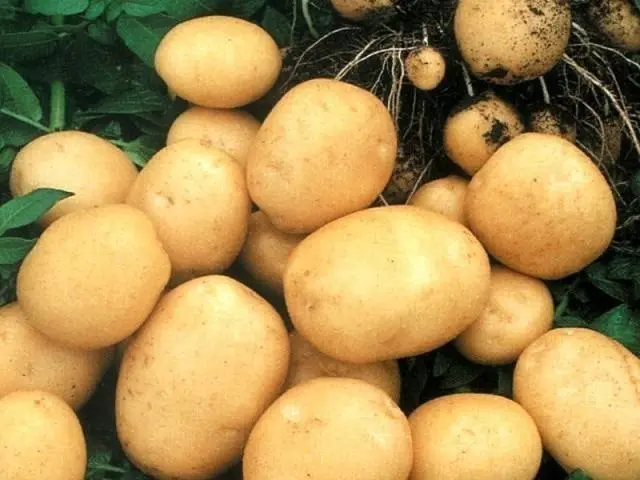
Rules of landing
The area for planting potatoes Kolobok should be prepared in the fall – deeply dug up and fertilized. In the spring, shallow plowing of the site and cleaning it of weeds with the simultaneous addition of phosphate and potash fertilizers will be enough. To speed up the ripening of potatoes Kolobok will help the implementation of simple rules:
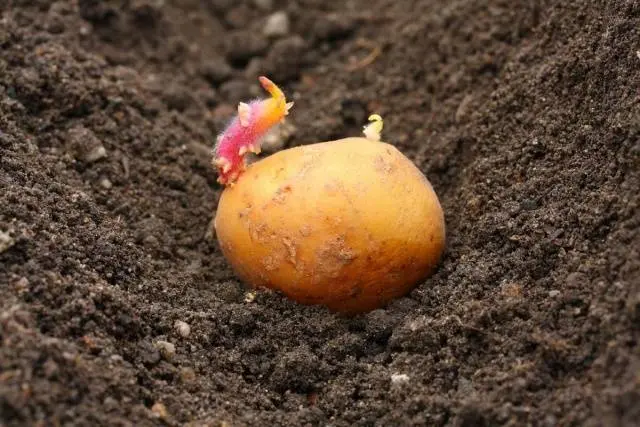
- the soil should warm up to +8 degrees to the planting depth, which is 10-12 cm, usually this period falls on the first half of May;
- in order for the eyes to begin to germinate, the soil must be moist, but excess moisture can damage the plants;
- arrange plantings in a north-south direction to provide the bushes with good illumination;
- if groundwater rises close to the surface, seeds should be planted in high beds;
- the gap between rows should provide easy care and be at least 60 cm, and between holes – 30-35 cm, depending on the size of the tubers;
- a handful of wood ash and the same amount of humus or compost should be added to each hole;
- they can be replaced with complex fertilizers at the rate of 20 g per hole.
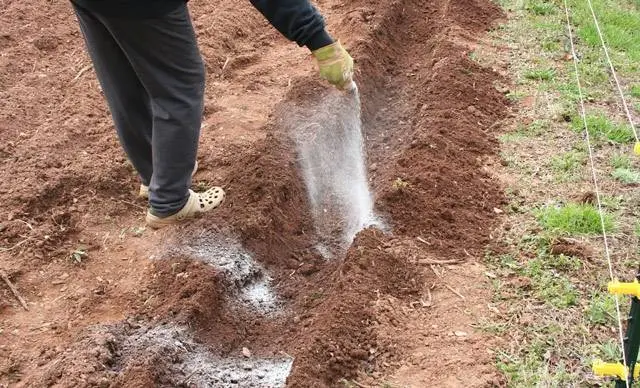
Preparation of planting material
Potato variety Kolobok perfectly adapts to different soils, although light soils are preferable. Not very whimsical in care. However, there are certain features that should be considered when growing it. For planting, you need to select high-quality medium-sized tubers that do not have damage. Otherwise, they will have extremely weak resistance to external factors:
- weather conditions;
- pests or diseases;
- soil features.
Pre-selected healthy seed material of the Kolobok variety is germinated in the light up to 2-3 cm before planting. Many additionally treat the tubers with agents such as Albit. Such treatment will accelerate the development of plants and protect them from pests and diseases.
Features of care
The first hilling of the Kolobok potato variety, judging by the description and photo, is carried out when the bushes grow to 25 cm. After 2-3 weeks, the next hilling is carried out. During this period, abundant watering is necessary, as the formation of ovaries occurs. In the dry season, haulm sprinkling is useful. After flowering, abundant watering of potatoes is harmful, it can lead to late blight infection. For its prevention, bushes can be treated with Polyram.
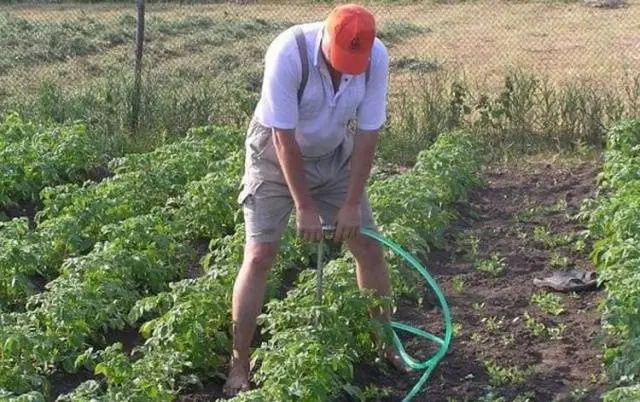
During the season, 2-3 feeding of potatoes Kolobok with potassium compounds in combination with mullein or droppings are necessary. During this period, nitrogen fertilizers are undesirable, as they will lead to the growth of green mass to the detriment of the fruits. To prevent the soil from drying out, hilling and mulching are used.
Fighting diseases and pests
Despite the high resistance of the Kolobok potato to common potato diseases, it is necessary to periodically carry out preventive treatments of the bushes. A two-time treatment of plantings with preparations containing copper is recommended. A good preventive measure is to change the site for a potato plantation. It is useful to choose beds for planting potatoes on which radish or cabbage grew.
The most common potato pests are aphids and the Colorado potato beetle. The wireworm harms the tubers by making moves in them. Against pests of the potato variety Kolobok, reviews advise using insecticides when treating bushes and soil. Special preparations are used against the Colorado potato beetle. To prevent the appearance of Colorado potato beetles, tools such as Bitiplex will help. When using chemicals, read the instructions carefully and follow them. If the potato plantation is small, then collecting beetle larvae will be an effective and environmentally friendly way.
Potato storage
In summer, you can partially dig up potatoes, but they fully ripen around mid-September. A sign of its ripening is the drying of the stems. Before harvesting, for convenience, cut off all the tops. The harvested crop is sorted and laid out under a canopy for drying. Even healthy tubers are selected for the seed fund of the Kolobok variety and, after drying, are laid for separate storage.
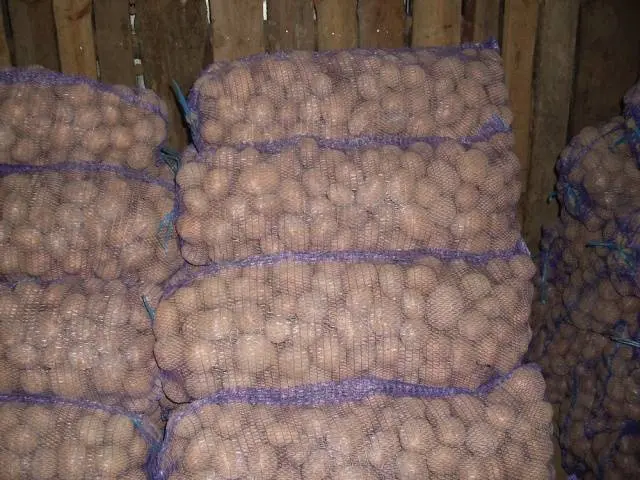
At home, potatoes of the Kolobok variety can be stored: in the basement or cellar, closet or pantry, in any dark unheated room.
Dried and sorted potatoes are placed in wooden boxes, pre-treated with a strong solution of potassium permanganate. The room must have a ventilation system to prevent:
- dampness;
- air stagnation;
- the appearance of fungus.
The potato storage area must also be well insulated to effectively protect potatoes from low temperatures in winter and high temperatures in summer. Styrofoam is often used as a heat-insulating material. Roofing material provides a high degree of waterproofing.
Reviews of producers and gardeners
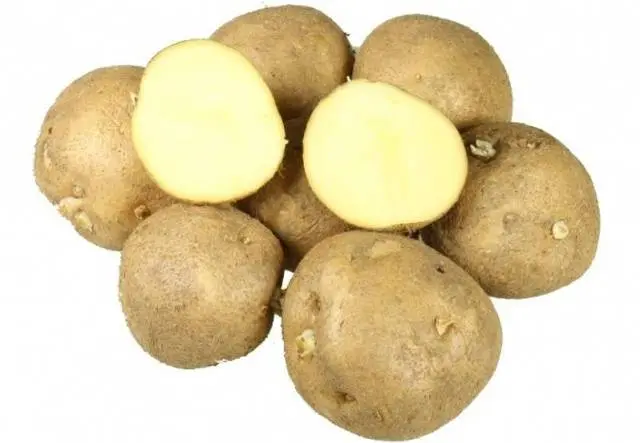
Conclusion
Potato Kolobok has excellent characteristics as an excellent mid-season variety with high yields. When following simple rules of care, it will provide tasty even tubers, which makes it popular among farmers.









